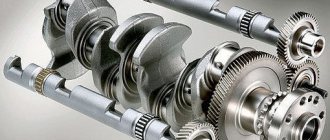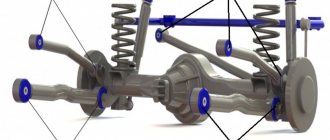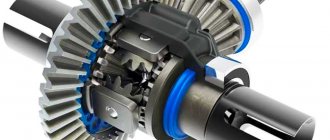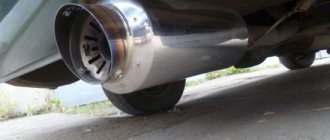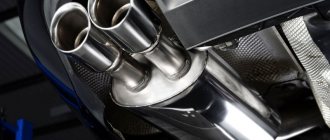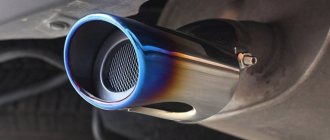Among the many technical devices that help improve the efficiency of a car, an ordinary thermal tape for the muffler can play a significant role. It turns out that with its help you can significantly increase engine power.
How to properly use thermal tape for a muffler
Nuances of installation work
For winding, it is better to use tape 4-5 cm wide. This will be easier to work with. Before starting the process, it is recommended to coat the collector with anti-corrosion paint, this will significantly extend its service life.
Next, follow the recommendations:
- Before winding, it is better to soak the tape in water for 1-2 hours. This will make it softer and more pliable.
- When winding, each subsequent layer should overlap the previous one by about half.
- After wrapping each section of the pipe, the thermal tape is fixed using metal clamps.
- At the very end, fold the tape inward so that there are no protruding edges.
The thicker the layer of winding material, the better the insulation, but do not forget that the thickness of the pipe also increases. Sometimes difficulties arise due to tight gaps. Therefore, before finally fixing the thermal tape with clamps, we advise you to install the manifold on the engine and make sure that all components match.
DIY winding
This work can be done on your own without the help of professional auto mechanics, but you are unlikely to be able to do it without an assistant. Difficulties can be caused by winding at joints and bends. Branching pipes cause even more difficulties, because here it is no longer possible to make the winding with one piece of tape.
Why do you need to wrap?
Those skeptics who doubt the ability of such thermal tape to increase engine power by several horsepower should give several of the most common arguments regarding what other significant advantages thermal tape provides for the muffler, and why it may be needed:
- This thermal tape helps eliminate the ringing, sometimes rattling sound in the muffler during the exhaust, which is observed quite often in practice. “Cushioning” is similar to how if a rubber lining was placed at the bottom of a metal dish - now when you throw a nut there, sound will be absorbed;
- Thermal tape helps reduce the temperature under the engine hood, which helps extend the life of many parts, primarily those made of plastic, as well as the car battery;
- The main advantage of thermal tape is increased motor power. It can be simply explained using physical laws. The fact is that the exhaust system, by its structure, contributes to the braking of exhaust gases. Therefore, the faster they are retracted, the easier it is for the engine to work, so that it does not spend additional significant effort “pushing” them through the muffler pipe. Having served their purpose, the gases enter the cold pipe of the exhaust manifold, immediately cooling and compressing, thereby reducing their exit speed. Thermal tape on the muffler prevents them from cooling quickly, that is, it becomes a constant assistant to the engine. Due to the fact that he does not have to spend extra effort on running them, the efficiency of the motor power increases, and this is the main argument in favor of why thermal tape is needed.
How to paint if necessary?
If you were unable to find thermal tape for a motorcycle muffler of a suitable color, and you wrapped the exhaust system with the most common (by the way, the cheapest) white stripe, then you can paint it. For this purpose, special silicone heat-resistant paints are used. They are usually sold in 400 ml aerosol cans.
One container will be enough. Price: 420-450 rubles per piece. As a result, thanks to savings on the cost of tape, the overall budget for restoration work will not be affected. In addition, such a coating will create an additional protective layer against moisture, gasoline and oil.
In order to ensure excellent conditions for the functioning of the car, it may be necessary to use thermal tape, which sometimes has to be wound around the muffler. With its help, the driver is able to significantly increase the engine power of the car. This article provides brief instructions on how to use such material, as well as the procedure for its practical use.
What is thermal tape for a muffler?
It came into use thanks to the construction industry. In it, and then in other industries, dense asbestos fabric with colossal heat-resistant characteristics was widely used. So, she was able to easily withstand temperatures up to 1500 degrees Celsius! This fabric became widespread, but then the process of its use began to noticeably slow down and fell to a minimum due to its obvious harmfulness to humans and their environment.
However, it is produced in a different way, using different silicon compounds (for example, silica filaments), original LR technology and other modern know-how. Despite a fundamentally different technological approach to their production, they have the same excellent heat-resistant properties and reliability. Ordinary thermal tape, widely used today in the car industry, is a strip approximately 5 cm wide of a thick black color, similar to graphite.
Properties and selection
The material is made from harmless silica filament and graphite compounds. Available in the form of a tape of a certain width, heat-resistant.
The use of such material for the muffler winding guarantees the following:
- Increased engine power.
- Increased ventilation of the combustion chamber.
- Thermal insulation.
- Reduced temperature under the hood.
When purchasing, some points are taken into account:
- Heat resistance up to 1500 degrees.
- The width is selected depending on the convenience of the winding. 5 cm is enough.
- Tone: black, white, bronze.
How to wind thermal tape onto a muffler correctly?
The winding process, despite its apparent simplicity, is quite complicated. Without knowing the subtleties, you can perform this work with violations, as a result of which there will be no effect and the money will be wasted.
The most important thing is to wind the thermal tape tightly and fix its beginning and end. First, the spider is prepared, as well as other parts of the exhaust. To do this, the pipes are cleaned and degreased. To avoid rust, the pipes are coated with a heat-resistant anti-corrosion coating before winding. The tape itself is wetted for a better effect; after winding, the wet tape dries and the tension density improves, as a result it will sit tighter.
Winding is done overlapping, not end-to-end. Each subsequent turn should overlap the previous one by about 5-10 mm as much as possible. It is important to secure the end of the thermal tape well; if this is not done, the tape will unwind after several cycles of heating and cooling. You can secure the tip with a clamp or a special knitting wire. The main thing is that the fasteners themselves are heat-resistant and not afraid of corrosion.
Repair or replacement
Even a bad replacement is better than a good repair, but not everyone can afford to change the exhaust system every year. It is possible to replace individual system components with cheap mild steel parts, but in this case you need to balance the cost of the part with the cost of the repair. In addition, not all manufacturers can guarantee full compliance of the replacement element with the original one in terms of configuration and attachment points. Pipe bending angles, distortions in different planes, flange and diametrical mounting dimensions can easily differ, so it is worth checking them before purchasing.
Video tutorial on replacing the outer shell of the muffler:
https://youtube.com/watch?v=wr7FWM6VsOQ
When deciding on a replacement, it is better to look at the products of trusted brands that produce kits not only for foreign cars, but also for VAZs - Walker, Bosal, Rosi, Tesh. High-quality Turkish and Polish spare parts also began to appear. The price of the finished part is influenced not only by the brand, but also by the material - a linear meter of a system made of ordinary steel will cost about 350 rubles, and stainless steel can cost twice as much. For example, a new muffler for an old Passat from IGL will cost 1,460 rubles.
Images of the muffler for the Passat B3.
Choosing what to wrap the exhaust manifold with - types and functions of materials
As you know from a physics course, the volume of a gas is directly proportional to the temperature, that is, the higher the latter, the greater the first parameter will be. It follows from this that heated exhaust gases will exit the car engine much faster. But in the engine compartment the air does not heat up above one hundred degrees, while the temperature of the car’s exhaust manifold is more than a thousand.
And again, returning to physics and the laws of heat transfer, it can be argued that the gases, due to such a low temperature in the engine compartment, are cooled, which means that the process of their release slows down. Thermal tape can solve all these problems by creating excellent thermal insulation of the manifold; it will retain heat in the exhaust system and at the same time prevent the engine from overheating from the heat released from the exhaust.
There are three main types of such tapes on the automotive market, differing in composition and color. The most common among car owners are black and white thermal tapes. In principle, they are at the same consumer level and are identical in their properties. Bronze is considered more effective; its thermal insulation properties are better than those of previous options by as much as 30%, and all thanks to a different composition.
Which method to choose
So, as it became known earlier, there are three main technologies for repairing a muffler without welding, and you can choose one among them only if you know the operating features of each:
- Cold welding. This is a simple and reliable way to repair the exhaust system. It does not require any special skills and ensures the strength of the connection, which is why it is so popular among car enthusiasts. The main thing is to choose the right composition, and everything else will not cause difficulties.
- Bandages. Most often used for parts that can be wrapped with them. For exhaust pipes, for example. They have a ceramic base and are also impregnated with compounds that can withstand high temperatures, up to 1000 degrees Celsius.
- Sealants. Not durable, but for minor damage, especially in seams - indispensable
If the damage is significant, then only replacing parts will help. This is the best way out of the situation.
It happens that a strange, unusually loud hum suddenly comes from under the car. And then even an ignorant driver understands that there is a problem with the jammer! Most often, burnouts occur; elements of this assembly are less likely to tear apart from each other.
But, fortunately, most breakdowns can be eliminated by repairing the muffler yourself. The main thing is to understand which of the following reasons led to the malfunction:
- hitting an obstacle that damaged the muffling element;
- corrosion, burnout of the unit due to constant exposure to harmful substances in exhaust gases, as well as their heat;
- constant strong exhaust pressure;
- large changes in ambient temperature.
Read also: What is a regular hexagon
If such a nuisance occurs, you should not postpone work on repairing such an important assembly unit, so as not to deafen those around you and yourself with the disgusting noise. In addition, the unit may simply fall apart
Next, we’ll look at how to repair a muffler with your own hands using the example of different cars.
How to wrap it with your own hands
Now I take the option - when you already have a pumped exhaust system (with SPIDERS) and you want to improve it even more.
- It is worth buying thermal tape from well-known manufacturers (as practice has shown, those purchased on ALI can be of poor quality, and contain asbestos).
- You need to take a thickness of about 40 - 50 mm - this is the best option. If you take it narrower than 30 mm or wider at 60 - 80 mm, it’s just more difficult to wind
- The collector MUST be treated with corrosion-resistant and heat-resistant paint - THIS IS MANDATORY, this way it will last much longer
- Before winding, the tape needs to be thoroughly wetted, in plain water for about an hour or two. This is done so that the thermal tape does not “walk” along the pipe in the future, but is wound as needed
- At each stage, you need to fix the winding parts with metal clamps. The structure itself, too, otherwise fixing this layer will be impossible
Usually only the exhaust manifold is treated (in our case it is an improved SPIDER). There is no point in treating the entire muffler, because the gases still lose temperature. However, if you want, you can!
Winding at home
In order for the winding of thermal tape to be as successful as possible, the master must take into account the following basic nuances in practice:
- the width of the source material should not exceed 50 mm, otherwise the processing of the muffler will become more difficult;
- the body of the workpiece must be completely covered with the insulating element;
- To cover the collector, you should first use a special anti-corrosion paint;
- Before direct winding, the thermal tape is wetted under water, and it must remain submerged for several hours.
When winding turns, the master must ensure that the pitch of the surface being processed is even and identical everywhere. And in order to secure the thermal tape more securely to the base, peculiar metal clamps are attached through a certain number of turns.
When treating the muffler with a similar component, the driver must also take into account that the pressure inside the system will become uneven, and this over time can lead to burning of the exhaust valves. And the thermal tape itself perfectly accumulates moisture and various dirt.
But in any case, treating the muffler with thermal tape is an effective step from a practical point of view, which in many cases is completely justified. And if a similar procedure was carried out by a person who knows the intricacies of the technological process well, then its implementation will certainly benefit the entire vehicle.
Thermal tape for the exhaust system - how to reduce engine noise?
The exhaust system of a car is designed to remove them directly from the engine cylinders, cool them, reduce noise and toxicity. The exhaust system of a car includes a wide variety of structural elements, which include: exhaust manifold, particulate filter, muffler, catalytic converter and connecting pipes. It is important to note that all structural elements of the vehicle exhaust system are located under the bottom of the vehicle.
- 1. Choosing what to wrap the exhaust manifold with - types and functions of materials
- 2. Thermal insulation of the exhaust manifold - when to act
- 3. Thermal tape for the exhaust system - how to use it correctly
Thermal insulation. What do we include in this concept? If you look at it, many motorists believe that this procedure is only a minor area in tuning, which does not play a special role for the successful functioning and operation of the entire vehicle. However, this kind of opinion is erroneous, since this direction plays a huge role in the proper and problem-free operation of a vehicle that has succumbed to the influence of tuning.
It is important to note that when arranging the space that is under the hood, there is little or no free space left, which will lead to inevitable overheating of some parts in the future.
Thermal insulation
Showing all 9 elements
Sorting
By price
Length
- 5000 (2)
- 10000 (1)
Filler for muffler, flame arrester ceramic 1200C° 1kg
Thermo Tec 11022 thermal tape White 2 in. x 50 ft.
Thermo Tec 11022 thermal tape Black 2 in. x 50 ft.
Thermo Tec 11031 thermal tape Copper 1 in. x 50 ft.
Ceramic thermal tape for exhaust manifold 1200C° 5m
Thermal tape for exhaust manifold ceramic 1200C° 10m
ThermoTape reflective thermal film for intake components 5m.
Heat-resistant paint Rust-Oleum Automotive 1093 C°.
Universal tie clamp Stainless steel
Application technology
The technology of winding exhaust system elements does not contain secrets. The main task is to ensure density and uniformity of laying.
Experts advise carrying out preparatory work before using the material on the collector. They include treating the “spider” with heat-resistant paint or special anti-corrosion compounds.
To obtain a layer of thermal insulation:
- Make several turns;
- Fix the initial section with a metal clamp (wire);
- Winding continued with overlapping turns of 1/3-1/2 the width of the tape;
- After a certain distance, the layer is additionally fixed with clamps (on the collector, due to its short length, installing 1-2 intermediate ones is sufficient).
- The end of the strip is carefully masked and also secured with a clamp.
Winding is carried out with force, which allows you to achieve the required packing density. Experts recommend moistening the material (place it in a container filled with water for 30-60 minutes) before use. After drying, the tape shrinks and adheres tightly to the surfaces.
Video with installation instructions.
The positive aspects of processing exhaust system elements with tape are determined by solving the underlying problems. Among the disadvantages of using the material are:
- Pressure created by a significant volume of hot exhaust gases. The result is increased load on the valve mechanism.
- Maintaining high temperatures inside system elements, leading to accelerated wear.
- Deposition of dirt, aggressive chemicals, and moisture absorption on the surface of the material. Treated parts lose their appearance over time, and constant contact with contamination provokes the accelerated development of corrosion processes.
Quite a high cost of the material.
Why wrap the muffler
There are several theories according to which thermal muffler tape, that is, this black tape, provides certain benefits to the car.
The use of such a winding is aimed at several tasks.
- Change in exhaust sound. Unlike replacing the catalyst with a flame arrester, when you want to reduce the noise level, thermal tape is aimed at improving the roar of the car. Tapes are usually used to eliminate the unpleasant ringing sound of the exhaust, trying to make it bassier and deeper;
- Increase in power. It is believed that winding with thermal tape allows you to add several horsepower to the motor. This is achieved by accelerating the removal of hot gas. Thus, power can really increase;
- Reduced temperature under the hood. Another positive quality of thermal tape. Helps protect plastic and rubber components, as well as the battery housing.
But in most cases, the tape is used by tuning fans. And they are not interested in anything other than an increase in power.
Adding power
The power here is in the form of an error, namely you can count on +3+4% (maximum)!!! Of course, if you have a properly tuned exhaust + install this tape, then it will be quite good, plus the sound will be deep.
BUT you shouldn’t hope that the increase will be +5+10%; I’ll emphasize once again - as practice shows, the MAXIMUM is 3 percent (I admit 4, no more)
If you just installed the SPIDER and wrapped it with this thermoelement (did not remove the catalyst and did not replace the resonators), then the increase may not be noticeable at all.
Now we are watching the video version.
This is where I end, I think my article was useful and interesting to you. Subscribe to our channel and website, there will be many more useful articles and videos.
Similar news
- Catalyst service life. When should it be changed?
- Water in the muffler. Reasons, how to get rid of it and whether it can be drilled
- Removing the catalyst. Pros and cons, consumption, firmware - revealed...
Add a comment Cancel reply
Varieties
Thermal tapes for the muffler are made on the basis of silica, expanded clay, basalt, carbon or ceramics. Such materials can withstand temperatures from 850 to 1100 degrees. These products are produced with a strip width of 25 mm or more. For motorcycles, the most convenient to use tape is 50 mm wide.
Until recently, it was possible to purchase stripes in only two main colors: white and black. Nowadays, such products appear on the market in a variety of colors. You can choose a ribbon that best matches the color of your motorcycle.
Depending on the material and manufacturer, a skein 10 m long costs from 1000 to 3500 rubles.
Thermal insulation of the exhaust manifold - when to act?
The design of the exhaust manifolds includes a steel screen, which also acts as thermal insulation. If, as a result of tuning or for some other reason, it is missing, then you cannot do without thermal tape. The temperature of the collector, as mentioned above, can reach as much as 1600 °C, and after stopping the engine it cools down quite quickly. Thus, condensation forms in it.
The following signs will help you understand that thermal insulation of the exhaust manifold is urgently needed. First of all, your “iron horse” will lose power, and problems with starting the engine are also possible, especially when the car stalls. Sometimes there are even cases where black smoke comes out of the exhaust pipe. In addition, a special light will light up on the instrument panel in the cabin, indicating that the engine is overheating.
Advantages of winding the muffler with thermal tape
The idea of using thermal tape to wrap a car muffler came to drivers for a reason. Basic knowledge of physics is enough to understand how, according to the promoters of this idea, it will be possible to increase motor power by winding tape:
- Since the thermal tape is resistant to high temperatures and retains heat, it reduces the cooling rate of the exhaust manifold through which exhaust gases pass;
- This leads to the fact that the engine has to spend less effort on “pushing” the exhaust gases, since they exit through a warm pipe, that is, they avoid the process of cooling and compression;
- By reducing the effort to release exhaust gases, engine power increases.
This theory is confirmed in practice. Enthusiasts measured the effectiveness of wrapping the muffler with thermal tape to determine whether the engine's power actually increased. There is an increase, but it is at a level of 3-4%; you should not believe information on automobile forums that talk about increasing engine power by up to 10%.
It is worth noting that increased power is not the only advantage that winding the muffler with thermal tape provides. Besides:
- The presence of thermal tape on the muffler reduces the temperature under the hood, which has a beneficial effect on plastic elements;
- Thermal tape can help if the driver's muffler is loose, causing rattling and ringing.
Perhaps these are the main advantages that thermal tape on the exhaust manifold provides.
Purpose
The main purpose of thermal tape for a muffler is to improve the appearance of the motorcycle. Over time, the components of the exhaust system rust, chrome elements lose their shine (and sometimes this coating is damaged or peeled off). By wrapping parts of the motorcycle with special tape, you will not only hide all defects, but also give it a brutal look. The second useful function of this material is to protect the motorcyclist’s feet from parts of the exhaust system that heat up to very high temperatures.
From a technical point of view, according to experts, tape winding reduces the cooling rate of exhaust gases, and, as a result, increases the rate of their release to the outside. This leads to an increase in engine power (albeit insignificant, only 2-3 l/s).
This coating increases the sound insulation of the exhaust system, although it is unlikely that any biker is embarrassed by the roar of the engine of his “two-wheeled friend.”
Disadvantages of processing
Of course, there are disadvantages and you need to think before wrapping:
- Volume of gases . As I already said, if you do not lower the exhaust temperature, the volume of gases remains large with the same mass. On the one hand, this is good - they leave faster. On the other hand, the exhaust pressure goes not only to the side (of the muffler), but also to the other side - the manifold itself; the exhaust valves may suffer, because they will heat up more.
- Metal . The outlet is either in front or almost under the car, it is moisture, salt, dirt, etc. All this “charm” will be packed into this thermal tape. Often leading to corrosion and premature failure of the exhaust system
- And of course the price . A high-quality option is not cheap, from 1500 to 2500 rubles per 10 meters
Are you ready to endure all these disadvantages? I think we are ready if there is an effect


